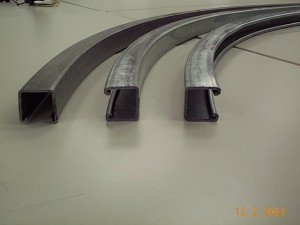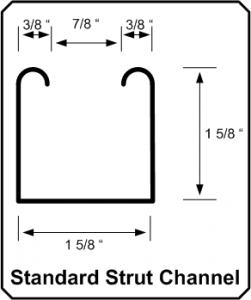Metal profiles that are regularly curved include standard mill shapes (angles, bars, beams, tees, pipe, tube, and channels. Another type of metal profile that can be curved is exemplifed by the strut channel.

Standard mill channel is formed hot in the steel production process; strut channel is formed cold from 12 gauge or 14 gauge steel strip by passing it through a series of rollers in a process called “roll forming.” Standard mill channels do not come with holes for attachment to each other or to building structures; strut channel often does. Whereas a standard mill channel is basically a flattened U shape, strut has an open channel metal profile with inwards curving lips.

Although most strut channel is used as straight members, it is able to be curved. Like standard mill channels, strut channel can be curved with the flanges in, with the flanges out, or with the flanges up—this last is sometimes called rolling channel “the hard way” or “the hard way of the web.” Curving metal profiles of this type takes care so as not to distort the dimensions of the strut channel. For example, when bending the strut channel the hard way, the flanges will have a tendency to fold inward.
Strut channel (also called variously”Flexstrut”, “Kindorf”, “Unistrut”, “SuperStrut”, “Strut”, and “Metstrut”), along with a wide variety of connectors, can supply light structural support for electrical, mechanical, heating, ventilating and air conditioning systems. Typically made of galvanized steel, strut also can be made of aluminum or stainless steel. Curved strut channel can be used in factory monorails or in the curtain system above a hospital bed. Maintaining critical dimensions will allow, for example, for the smooth gliding of wheels through the channel profile. The main advantage of strut channel in construction is that there are many options available for rapidly and easily connecting lengths together and other items to the strut.
In US units, the basic typical strut channel forms a box 1 5/8 inch by 1 5/8 inch. There are several additional sizes and combined shapes manufactured.







